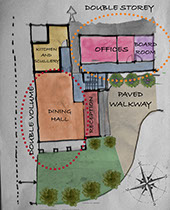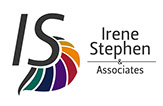OUR WORK
ADANTÉ HOTEL
Project Details
Expand existing guest house into a 20-room boutique hotel : 2018
Stages: 1 to 6 (Stage 2 as at 2021)
Architects: Irene Stephen & Associates

-1-crop-u26406.jpg?crc=3789054667)
The Client has been in the hospitality business for over 20 years and runs two successful BnB’s as well as a catering business. To signify the business’ growth and to expand the business in order to meet the growing demand of her services, the client aims to build and own a boutique hotel by 2022.
A NEW SI[GH]TE
The client’s brief was straightforward. She wished to demolish the existing 1980s-style buildings which currently house the BnB guests and build a new modern-style 40-room boutique hotel (later reduced to 26 units) that includes a dining hall, a conference facility and swimming pool. The capital to build the boutique hotel is a combination of the client’s savings and a building loan – a bulk of which shall be spent on purchasing the parcel of land for the new development. Consequently, a limited building budget was the main factor that affected the design.
Despite the financial constraints, the design endeavoured to be an engaging and visually sophisticated piece of architecture that would be the model boutique hotel in the city. Such a feat, however, could not be realized by employing similar or out-dated design language and style.
Firstly, the ample use of structural steel and full length aluminium-framed windows in single and double volume spaces were intended to give the building a modern and timeless appearance while dramatically reducing the use of static materials (such as facebrick) which in preliminary cost studies of the project worked out to be more expensive per square meter.
The transparent glazing of the full length windows was also used to communicate the grandeur of the building and from the outside, display the more relaxed human activities that hospitality spaces naturally compel such as people wining and dining and guests being concierged, etc.
Secondly, the use of different materials in varying quantities and volumes aimed to further communicate the hotel’s commitment to a new architectural interpretation. For example, the mono-pitched IBR roof sheeting was also used to clad certain portions of the walls bestowing the building with an Industrial expression starkly contrasting the more Modern Architecture expressions of the building such as the flat concrete roof and the glass façade.
In sum, the introduction of a new design vision conveyed via volume, materiality and silhouette using clean, uncluttered lines and shapes define the overall design intent of the boutique hotel and is programmed to create a new experience for both visitors of the hotel and the urban fabric of Umtata.
-1-crop-u26422.jpg?crc=4194329826)
-1-crop-u26404.jpg?crc=3938619104)
IN LIVING COLOUR
One of the points of departure for designing the hotel was establishing its character in relation to the total design intent. This required looking at the architecture and interior design to be as unique as the operations of a boutique hotel. Boutique hotels typically have an eccentric personality. They are trendy, quirky and offer an alternative style to more traditional hotel chains. The Architect resolved to use colour to commune those traits. A palate of seven (7) bright pastel paint colours was used frequently and repetitively on the exterior. The use of bold colour sought to articulate the building’s overall impression and significance.
Experimentation with colour in the project was not meant to rigid. Indeed, although the hotel is a place of rest and relaxation, it remains a business; a business that relies on accommodating as many people as frequently as possible. To that end, colour was used a creative device - subliminally inviting and signalling that the hotel is open to an array of people such as business executives, young couples, curious teenagers, touring families, etc. Professor of Architecture Suné Lindstrom’s remarks on the use of colour in architecture that: “With every particular architectural product, it is the spontaneous emotional reaction that is important to us” reinforced the Architect’s elaborate use of colour to appeal to the people’s desire to experience the building.
-1-crop-u26420.jpg?crc=478271212)
-3-crop-u26410.jpg?crc=3912515557)
FIRST IMPRESSIONS
While boutique hotels provide plenty room for creativity through the use of different materials, colours and finishes there are still spaces that require restraint and poise; not to undermine the architectural/interior design potential of the space but instead, for the space to command respect and making a lasting first impression.
The reception area of the hotel exemplifies how restraint and poise were exercised with respect to the interior design and planning. This was executed in two (2) ways:
1. Neutral colour palette:
Unlike the general exterior of the building that features an exciting and vibrant colour palette, the interior uses a neutral and refined colour palette: Beige1 for the wall paint and Light Grey2 for the carpet. Next, rich and deep colours of Crimson3 and Anthracite Grey4 were selected for the furniture and ornament accents. They functioned to create a beautiful contrast and definition to the area whilst highlighting the unique selection of furniture pieces. Lastly, Wood5 (used for the reception desk, wall décor, built-in cupboards) and Stainless Steel6 textures (used for the hotel signage, ironmongery, etc.) were used to bind the visual impact of the colour palette.
2. Creating spaces that prompt relaxation:
The conceptualization and planning of the reception area was contemplated in a way that design consistency and psychology would overlap to produce a relaxing experience for visitors. The clean, uncluttered lines that define the entire building were deliberately continued into the interior to denote order and spaciousness. In addition, the natural light that permeates through the full-length windows and automated sliding door impose a lightness and airiness to the space that psychologically influences visitors in a positive, relaxing way.
-1-crop-u26427.jpg?crc=451262948)
INTELLIGENT DESIGN
Various measures towards making the building sustainable were adopted via passive design and intelligent use of building methods, materials and systems. The design prioritized three main areas of sustainability:
1. Sun Screening
75 × 25 × 2mm thick cold-rolled rectangular hollow section steel tubes welded to the I-Section structural steel columns on the northern façade of the Conference Facility act as blinds to limit the amount of heat that enters the building on hot summer days, therefore reducing the use of mechanical ventilation systems.
2. Renewable Energy
The hotel rooms are designed in an “L” shape and orientated to face north and west so that they receive sunlight most of the day. The mono-pitched roofs slope at a 6-degree fall. This allows the solar panels on the roof to be exposed to the sun more effectively in order to absorb as much thermal energy as possible. The solar panels provide a supplement of electrical energy to light the rooms and for heating water.
3. Rainwater Harvesting
The building was designed to harvest rainwater to reduce municipal water usage for irrigating the hotel’s soft landscaping. A range of indigenous monsoon flowers (flowers that grow in rainy weather) such as Hibiscus and Jasmine form a significant part of the site’s soft landscape architecture. The slope of the mono-pitched roof directs the rainwater to fall and water the flowers/trees planted on the ground below along the perimeter of the front façade of the hotel rooms.
Conversely, the mono-pitched roof system of the Conference Facility is designed to channel water for storage. Rainwater from the roof is channelled to a 150 × 150mm galvanized steel gutter. The gutter acts as a catchment system and leads the water to an adjacent fibreglass water tank where the water is stored. The stored water may be used as an alternative water source or for irrigation.
Quick Navigation
Get in touch
34 Nicolai Street
Hillsboro
Bloemfontein, 9301
+27 (0)51 436 2344
+27 (0)86 556 3862
info@irene-steph.co.za
© 2016 - 2022, Irene Stephen & Associates, Bloemfontein.
All rights reserved. Developed by: Irene Stephen & Associates, ITC Services.
